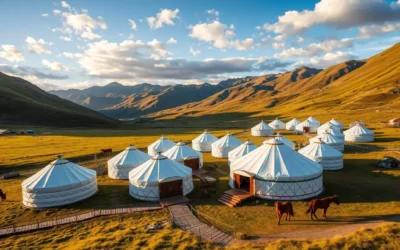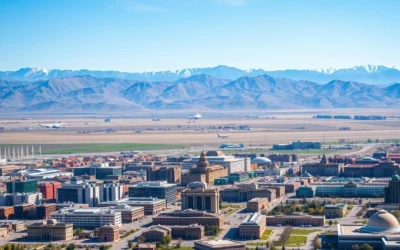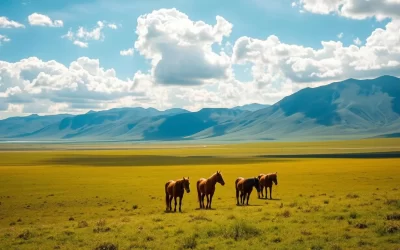✓ Accommodations ✓ Flights ✓ Rental Cars ✓ Tours & Activities
When planning your next trip, understanding exchange rates can make a huge difference. For example, did you know that the mid-market rate is often the fairest way to convert your money? This rate avoids extra fees charged by banks or currency exchange services.
Using a travel debit card or credit card can also help you save. These cards often offer low foreign transaction fees and let you spend like a local. Plus, they’re safer than carrying large amounts of cash.
Whether you’re withdrawing money from an ATM or exchanging currency, knowing your options can make your trip smoother. Start planning your financial strategy today to avoid unnecessary costs and enjoy your adventure stress-free.
Introduction to Mongolia’s Currency Scene
Getting familiar with the currency scene can make your travels smoother. In this part of the world, the official currency is the Mongolian Tögrög, often abbreviated as MNT and symbolized by ₮. This unique currency plays a central role in daily life, from bustling markets to remote villages.
Understanding how locals use money is essential. While cards are accepted in cities, cash remains king in rural areas. Preparing in advance can save you from unnecessary hassle. For example, carrying small denominations like 100, 500, and 1000 MNT notes is a smart move for smaller transactions.
The exchange rate for MNT varies, but it’s typically around 2000-2400 MNT per US dollar. Knowing this can help you budget effectively. Using a travel debit card or credit card with low foreign transaction fees is also a great way to manage your spending.
Local payment methods might differ from what you’re used to. While modern options like card payments are growing, traditional cash transactions are still common. This blend of old and new adds to the charm of experiencing the culture firsthand.
“Understanding the local currency is not just about numbers—it’s about connecting with the people and their way of life.”
By appreciating the balance between modern and traditional practices, you’ll feel more confident navigating the monetary landscape. Whether you’re exchanging foreign currency or making an ATM withdrawal, being prepared ensures a stress-free trip.
Exploring the Mongolian Monetary System
The way a nation handles its finances reveals a lot about its culture. In this part of the world, the Bank of Mongolia plays a central role in shaping the economy. It oversees the exchange rate, manages inflation, and ensures financial stability. Understanding its functions can help you make smarter decisions with your travel money.
Local banks and financial institutions bridge the gap between traditional cash and modern digital transactions. While cities embrace card payments and mobile options, rural areas still rely heavily on cash. This blend of old and new reflects the country’s unique economic landscape.
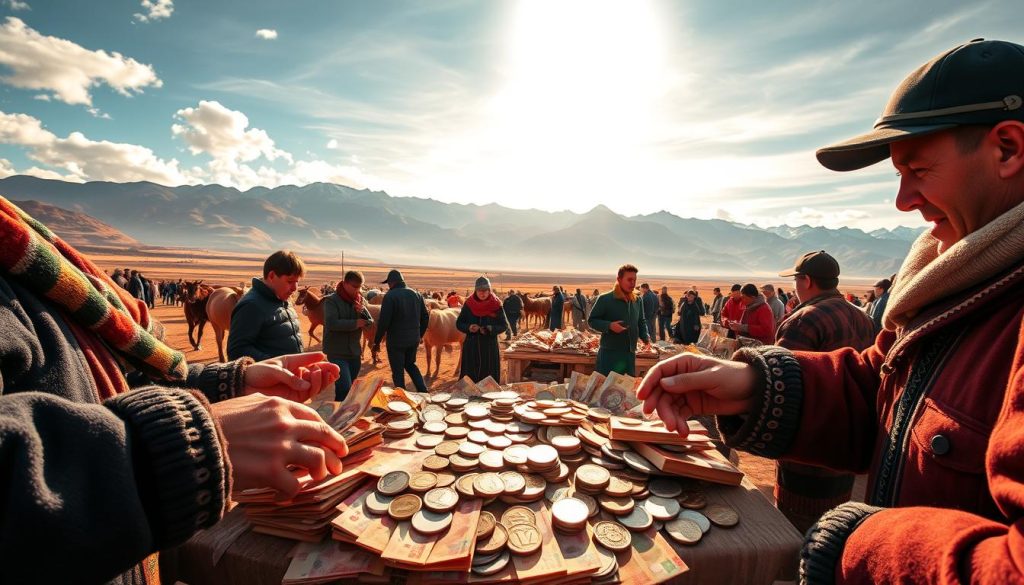
Exchange rates here are influenced by global markets and local demand. For instance, the mining sector, which accounts for a significant portion of exports, impacts the value of the currency. Knowing this can help you plan your spending better.
Daily transactions often involve small denominations like 100, 500, and 1000 MNT notes. Carrying these can make purchases smoother, especially in markets or remote areas. Pro tip: Always check for extra fees when exchanging foreign currency or making an ATM withdrawal.
“Understanding the monetary system isn’t just about numbers—it’s about connecting with the people and their way of life.”
By appreciating how money flows here, you’ll feel more confident navigating your financial needs. Whether you’re using a travel card or handling cash, being prepared ensures a stress-free trip.
Understanding Mongolian Tögrög: Currency Essentials
Handling money in a new place can feel overwhelming, but knowing the basics makes it easier. The official currency here is the Tögrög (MNT), with smaller units called Möngö. While Möngö is rarely used today, understanding the full range of banknotes and coins is essential for everyday transactions.
Banknotes come in denominations like 1, 5, 10, 20, 50, 100, 500, 1,000, 5,000, 10,000, 20,000, and 50,000 MNT. Coins include 20, 50, 100, 200, and 500 MNT. Carrying smaller notes, such as 100 or 500 MNT, is helpful for markets or small purchases.
Recognizing genuine currency is crucial. Look for watermarks, security threads, and raised print on banknotes. Counterfeit notes are rare but can still appear in busy areas. Always check your money carefully, especially when exchanging foreign currency.
In daily life, cash is widely used, especially in rural areas. While card payments are growing in cities, having enough MNT ensures you’re prepared for any situation. Knowing the exchange rate helps you budget effectively and avoid unnecessary fees.
“Mastering the local currency isn’t just about numbers—it’s about connecting with the culture and making your trip smoother.”
By understanding the Tögrög and its denominations, you’ll feel more confident handling cash and making payments. Whether you’re shopping at a market or paying for a meal, being prepared ensures a stress-free experience.
Exchanging and Managing Money in Mongolia
Managing your finances while abroad doesn’t have to be stressful with the right preparation. Whether you’re exchanging foreign currency or withdrawing cash, knowing your options can save you time and money. Let’s explore the best ways to handle your travel money efficiently.
Exchanging Money Before Travel
Exchanging your home currency into MNT before arriving can give you a head start. Airport exchanges often charge higher fees and offer less favorable exchange rates. Instead, consider exchanging in your home country or using a travel card for low-cost conversions.
Researching rates in advance helps you lock in better deals. For example, the mid-market rate is often the fairest option, but it’s not always passed on to customers. Avoid dynamic currency conversion, as it can lead to unnecessary extra fees.

Withdrawing Cash Locally and Using ATMs
ATMs in major cities like Ulaanbaatar are widely available and offer secure cash withdrawals. Most accept Visa, Mastercard, and other international cards. Always check for transaction fees and notify your bank before traveling to avoid issues.
Carrying some cash is essential, especially in rural areas where card payments may not be accepted. Smaller denominations like 100 or 500 MNT notes are handy for markets and tipping. Remember, cash withdrawal limits and fees vary by bank, so plan accordingly.
“Preparation is key to avoiding unnecessary costs and enjoying a stress-free trip.”
| Option | Pros | Cons |
|---|---|---|
| Exchange Before Travel | Better rates, no airport fees | Limited availability of MNT |
| ATMs in Cities | Convenient, secure | Potential withdrawal fees |
| Travel Card | Low-cost conversions, easy to manage | May have usage limits |
By planning ahead and understanding your options, you can make the most of your spending while abroad. Whether you prefer cash or cards, being prepared ensures a smooth and enjoyable experience.
Payment Methods in Mongolia: Cash, Cards, and Mobile Options
Navigating payment options in a new country can feel daunting, but with the right knowledge, it becomes a breeze. Here, you’ll find a mix of traditional and modern methods to suit every need. Whether you prefer the convenience of cards, the speed of mobile payments, or the reliability of cash, there’s a solution for you.
Using Debit and Credit Cards for Hassle-Free Payments
Debit and credit cards are widely accepted in cities, making them a convenient choice for larger purchases. Many card providers offer low foreign transaction fees, saving you money on every swipe. However, always check for any extra fees before using your card abroad.
For smaller towns or rural areas, carrying a travel card is a smart move. These cards often allow you to withdraw cash at ATMs without hefty charges. Just be mindful of daily withdrawal limits to avoid surprises.
Embracing Mobile and Contactless Payment Options
Mobile payments are gaining popularity, especially in urban centers. Apps like Apple Pay and Google Pay are accepted at many stores and restaurants. This payment method is not only fast but also secure, reducing the need to carry physical cards or cash.
Contactless payments are another great option for quick transactions. They’re perfect for busy markets or when you’re on the go. Just ensure your device is set up for international use before your trip.
Handling Cash for Small Transactions
Cash remains essential for smaller purchases, tipping, and rural areas where cards may not be accepted. Carrying smaller denominations like 100 or 500 MNT notes ensures you’re prepared for any situation.
When withdrawing cash from ATMs, look for those located in secure areas like banks or shopping centers. Always check for transaction fees and notify your bank in advance to avoid issues.
“Combining multiple payment options ensures flexibility and peace of mind during your travels.”
By understanding the available payment methods, you can choose the best option for each situation. Whether it’s a card for convenience, mobile payments for speed, or cash for reliability, being prepared makes your trip smoother.
Dealing with Foreign Transaction Fees and Dynamic Currency Conversion
Dynamic currency conversion might seem convenient, but it often comes with hidden costs. When making purchases abroad, merchants may offer to charge you in your home currency instead of the local one. While this might feel familiar, it usually means paying a higher exchange rate and additional fees.
Foreign transaction fees are another common expense. These fees, typically 1% to 3% of each purchase, are charged by your card provider for international transactions. Over time, these small percentages can add up, impacting your travel money.
To avoid these costs, always insist on paying in the local currency. This ensures you get the best possible exchange rate without extra charges. Additionally, using a travel card with low foreign transaction fees can save you money on every purchase.
Here are some simple strategies to minimize fees:
- Check your card statements for extra fee notices after overseas purchases.
- Use ATMs in secure locations to avoid high withdrawal fees.
- Notify your bank before traveling to prevent transaction issues.
“Paying in local currency is the smartest way to avoid unnecessary costs and make the most of your spending.”
By understanding these practices, you can manage your travel money more effectively. Whether you’re using a card or withdrawing cash, being informed ensures a smoother and more cost-effective trip.
Mongolia: Ultimate Travelers Guide to Currencies & Payments
Maximizing your travel budget starts with understanding how to convert currency efficiently. One of the best ways to save money is by targeting the mid-market rate. This rate, also known as the interbank rate, is the fairest option for currency conversion, as it avoids the extra fees charged by banks or exchange services.
Timing your conversion can also make a big difference. For example, converting your money before major expenses, like flights or accommodations, can help you lock in favorable rates. Tools like online rate trackers can keep you informed about the best times to exchange your currency.
Converting Foreign Currency at the Mid-Market Rate
When converting foreign currency, always aim for the mid-market rate. This rate is the midpoint between the buy and sell prices of a currency pair and is often the most transparent option. Avoid dynamic currency conversion, which may seem convenient but usually comes with hidden costs.
Using a travel card can simplify the process. These cards often offer low-cost conversions and allow you to spend like a local. Additionally, they’re safer than carrying large amounts of cash and can help you avoid unnecessary fees.
Strategies to Manage Travel Expenses
Managing your daily spending effectively requires a solid plan. Start by setting a daily budget and tracking your expenses. Apps and online tools can help you stay on top of your money and avoid overspending.
Carrying a mix of cash and cards ensures you’re prepared for any situation. While cards are convenient for larger purchases, cash is essential for smaller transactions, especially in rural areas. Always check for extra fees when withdrawing cash from ATMs.
| Conversion Method | Pros | Cons |
|---|---|---|
| Mid-Market Rate | Fair, transparent | May require planning |
| Travel Card | Low-cost, secure | May have usage limits |
| Dynamic Conversion | Convenient | Higher fees |
“Planning your currency conversion and daily spending can save you money and make your trip more enjoyable.”
By understanding these strategies, you can make the most of your travel money and enjoy a stress-free adventure. Whether you’re converting currency or managing expenses, being prepared ensures a smoother experience.
Tips for Using Travel Debit Cards and Multi-Currency Accounts
Travel debit cards and multi-currency accounts are game-changers for smart spending. They help you avoid unnecessary fees and give you better control over your exchange rate. With the right card, managing your travel money becomes seamless and secure.
Choosing the right card can save you from high foreign transaction fees. For example, cards like Wise and Monzo offer low-cost conversions and free ATM withdrawals. These features make them ideal for frequent travelers who want to keep their spending in check.

Multi-currency accounts add an extra layer of convenience. They allow you to hold multiple currencies in one account, making it easy to switch between them as needed. This flexibility ensures you’re always prepared, no matter where your travels take you.
Here’s why these cards are worth considering:
- Low or no foreign transaction fees.
- Access to the mid-market rate for fair conversions.
- Free ATM withdrawals up to a certain limit.
- Easy fund management through mobile apps.
“Using a travel card isn’t just about saving money—it’s about making your trip smoother and more enjoyable.”
When selecting a card, consider factors like ATM withdrawal limits, fees, and currency support. For instance, Wise supports over 40 currencies, while Monzo is great for USD holders. These details can make a big difference in your overall cost.
| Card | Key Features | Fees |
|---|---|---|
| Wise | 40+ currencies, mid-market rate | Low ATM fees after free limit |
| Monzo | No foreign transaction fees | Free ATM withdrawals |
| Chime | No monthly fees | $2.50 out-of-network ATM fee |
By using these tools, you can simplify your payment process and focus on enjoying your trip. Whether you’re withdrawing cash or making a purchase, the right card ensures you’re always in control of your money.
How to Navigate Currency Exchange Providers and Banks
Finding the best currency exchange provider can save you time and money. With so many options available, it’s essential to know where to look and what to avoid. Start by steering clear of airport exchanges, as they often charge higher fees and offer less favorable exchange rates.
For better deals, head to city-center exchange offices. These locations typically provide more competitive rates and lower costs. Before committing, compare rates and fees online to ensure you’re getting the best value. Tools like online rate trackers can help you stay informed about current market conditions.
Verifying the legitimacy of a provider is crucial. Look for reviews and ratings from other travelers to gauge their reliability. Trusted providers often have a strong reputation and transparent policies. For example, well-known banks like Chase or Wise offer secure and low-cost options for exchanging currency.
Here are some tips to help you navigate the process:
- Compare rates and fees online before visiting an exchange office.
- Read reviews to ensure the provider is trustworthy.
- Use banks or established providers for secure transactions.
“Choosing the right exchange provider isn’t just about saving money—it’s about ensuring a smooth and stress-free experience.”
By following these steps, you can make informed decisions and maximize your travel money. Whether you’re exchanging cash or using a travel card, being prepared ensures you get the best value for your spending.
Navigating Mongolia’s Financial Landscape: Culture and Local Practices
Exploring the financial culture of a new destination can enrich your travel experience. In this region, money management reflects a blend of tradition and modernity. Understanding these practices helps you connect with locals and adapt seamlessly to their way of life.
Understanding Local Spending Habits
Locals here often prefer cash for smaller transactions, especially in rural areas. Markets, street vendors, and public transport typically operate on a cash-only basis. Carrying smaller denominations like 100 or 500 MNT notes ensures you’re prepared for everyday purchases.
In urban centers, card payments are becoming more common. Restaurants, hotels, and larger stores often accept credit and debit cards. However, it’s still wise to keep some cash handy for unexpected situations.
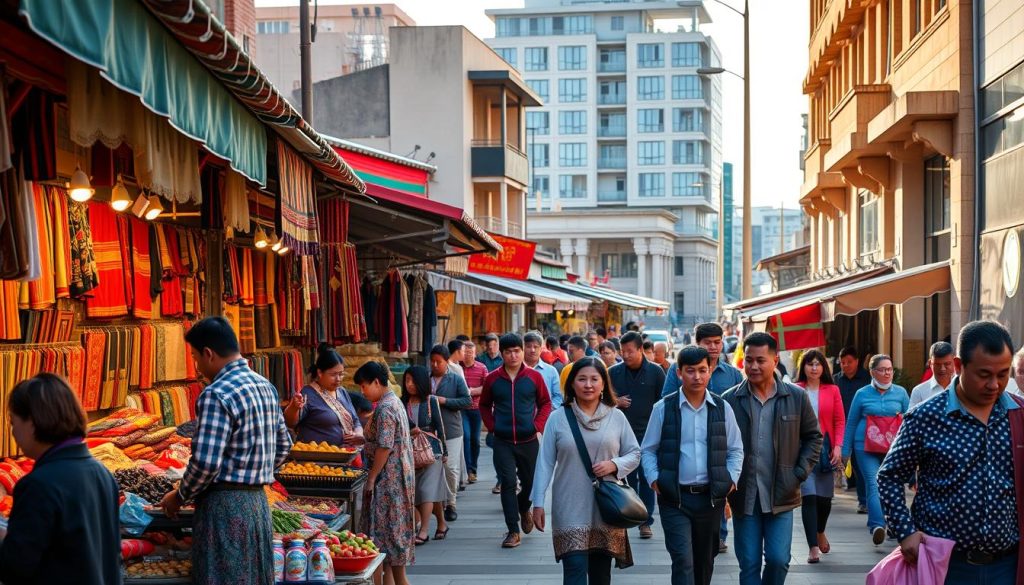
Insider Advice from Experienced Locals
Seasoned locals recommend negotiating prices at markets for a better deal. This practice is common and can save you money on souvenirs and local goods. Always approach negotiations with a friendly attitude to build rapport with sellers.
When dining out, tipping isn’t mandatory but is appreciated. A small amount of cash as a gesture of gratitude goes a long way. For larger purchases, using a travel card with low foreign transaction fees can help you save.
“Adapting to local financial practices isn’t just about saving money—it’s about embracing the culture and making your trip more meaningful.”
By blending traditional and modern payment methods, you’ll navigate the financial landscape with ease. Whether you’re shopping at a bustling market or dining in a city restaurant, understanding local habits ensures a smoother and more enjoyable experience.
Avoiding Additional Transaction Fees and Hidden Costs
Keeping your travel budget intact requires avoiding unnecessary fees and hidden costs. These extra charges can quickly add up, eating into your travel money. By planning ahead and making smart choices, you can save significantly.
One of the most common pitfalls is dynamic currency conversion. This happens when a merchant offers to charge you in your home currency instead of the local one. While it might seem convenient, it often comes with higher exchange rates and hidden fees. Always opt to pay in the local currency to avoid these costs.
Another way to save is by using a travel card with low foreign transaction fees. These cards often provide access to the mid-market rate, which is the fairest option for currency conversion. They also reduce the need to carry large amounts of cash, making them a safer choice.
Here are some practical tips to avoid extra fees:
- Read the fine print on your bank or travel card statements to spot hidden charges.
- Compare exchange rates before converting currency to ensure you’re getting the best deal.
- Use ATMs in secure locations and notify your bank before traveling to avoid transaction issues.
“Avoiding unnecessary fees isn’t just about saving money—it’s about making your trip smoother and more enjoyable.”
By following these strategies, you can keep your spending under control and focus on enjoying your adventure. Whether you’re using a card or withdrawing cash, being informed ensures a stress-free experience.
Budget-Friendly Tips and Insights for Travelers in Mongolia
Exploring remote areas doesn’t have to break the bank if you plan wisely. With a few smart strategies, you can stretch your travel money further and enjoy every moment of your adventure. Here’s how to make the most of your budget, even in the most remote corners of the country.
Smart Spending Strategies in Remote Areas
When venturing into rural regions, resources can be scarce, and prices may fluctuate. To avoid overspending, always carry a mix of cash and a travel card. While cards are convenient, many small vendors and local markets only accept cash. Having smaller denominations like 100 or 500 MNT notes can make transactions smoother.
Seasonal changes can also impact costs. For example, during peak travel months, prices for accommodations and tours may rise. Planning your trip during shoulder seasons can help you save significantly. Additionally, booking group tours can reduce expenses, as shared costs often lead to better deals.
Here are some actionable tips to keep your spending in check:
- Compare exchange rates before converting currency to get the best deal.
- Use a travel card with low foreign transaction fees to avoid extra costs.
- Carry enough cash for small purchases, especially in areas where card payments aren’t accepted.
“Smart planning and flexibility are the keys to enjoying remote areas without overspending.”
By balancing your payment methods and staying aware of seasonal trends, you can explore even the most remote regions without financial stress. Whether you’re trekking through the countryside or visiting local markets, these tips ensure you get the best value for your money.
Conclusion
Making the most of your adventure starts with smart money management. By understanding the exchange rate and using a mix of cash and a travel card, you can avoid unnecessary fees and stay in control of your spending. Planning ahead ensures you’re prepared for any situation, whether you’re in a bustling city or a remote area.
Remember to compare rates before converting currency and notify your bank to avoid transaction issues. Carrying smaller denominations of cash is helpful for markets and tipping, while a travel card offers convenience and security for larger purchases.
With these tips, you can focus on enjoying your journey without financial stress. Embrace the blend of traditional and modern payment methods, and feel confident knowing your money matters are well-handled. Happy travels!
The above is subject to change.
Check back often to TRAVEL.COM for the latest travel tips and deals.
Here are some Tours & Sightseeing suggestions that might pique your interests!

